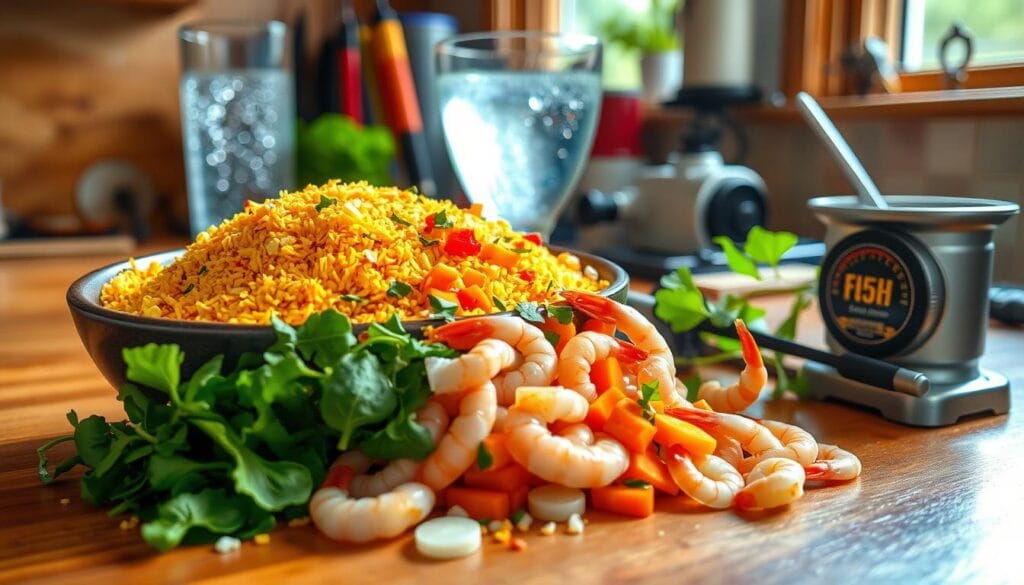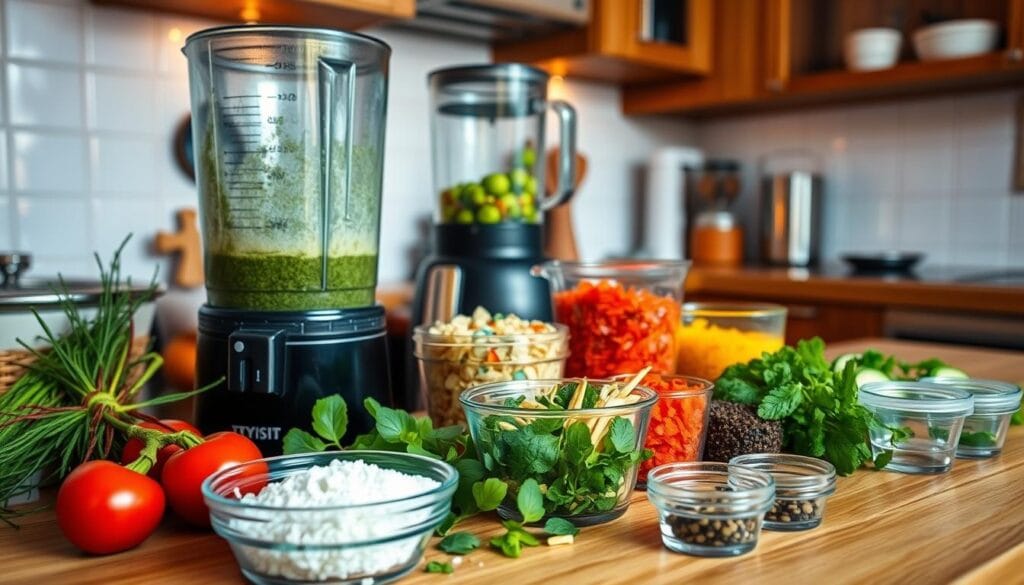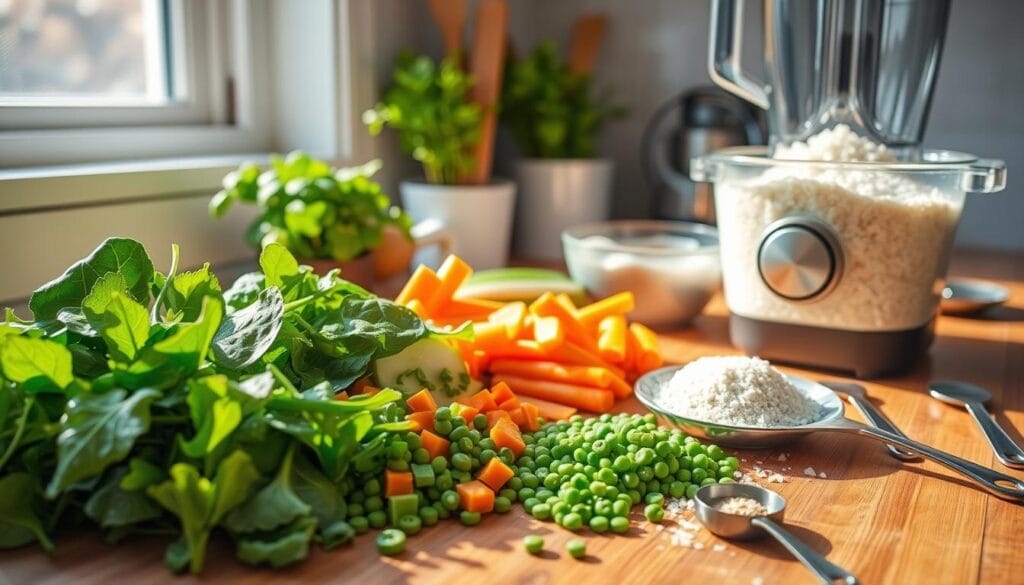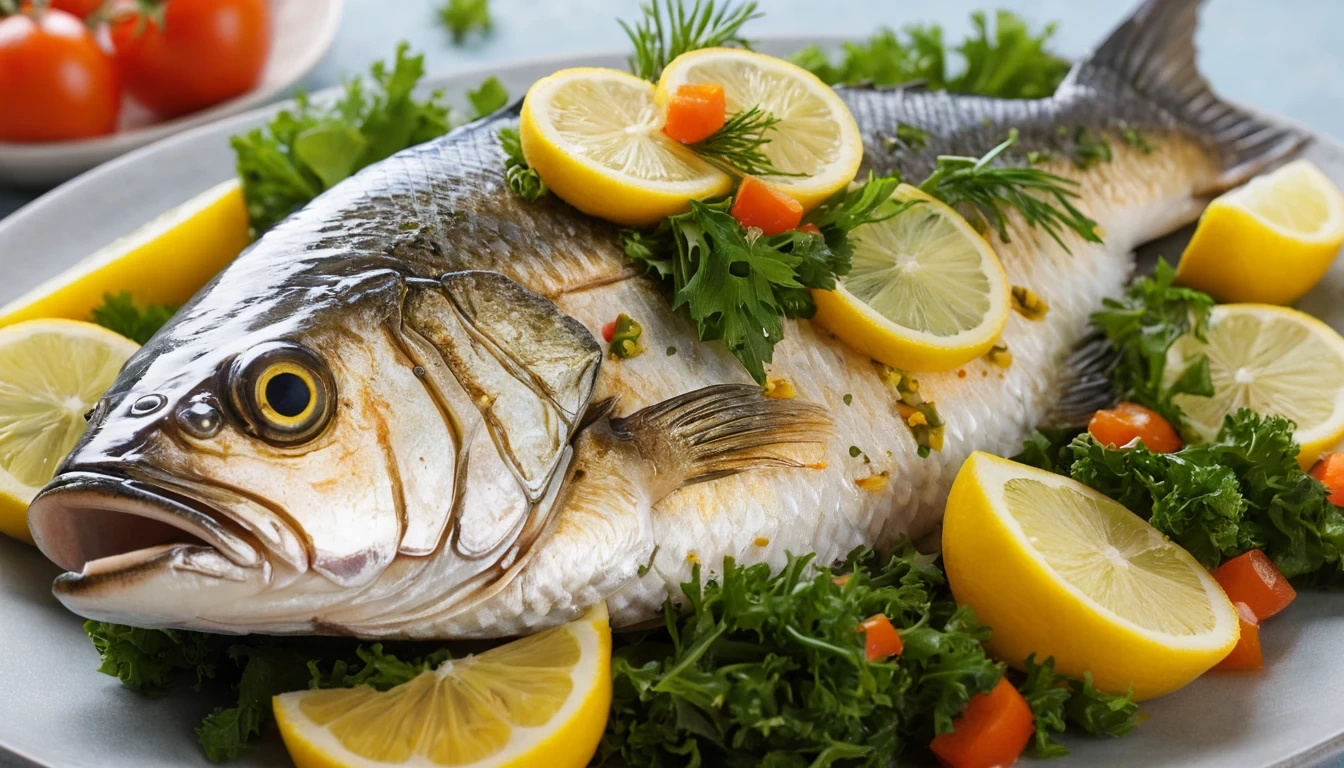As an aquarium enthusiast, I’ve learned that making the perfect fish food recipe can really help your fish. It’s all about giving them nutritious meals that are better than what you can buy.
Creating an easy fish food recipe is more than just adding food to their tank. It’s about taking care of your underwater friends. Whether you’re new to fish keeping or have been doing it for years, making your own food is a great idea. It lets you pick the ingredients, keep them fresh, and tailor the food to what your fish need.
Knowing how to mix the right amounts of proteins, vitamins, and minerals is key. This guide will show you how to make a tasty and healthy fish food recipe. Your fish will thank you!
Spending a bit of time on homemade fish food can really pay off. You’ll see your fish’s energy, color, and health improve. Let’s explore the world of nutrition together and become fish food masters!

Understanding the Importance of Fish Nutrition
Nutrition is key to keeping your fish healthy and lively. Making a homemade fish food recipe is a great way to meet their needs. It can greatly improve your fish’s health.
Fish need a balanced diet for growth and health. Each fish type has its own nutritional needs. You must consider these when making your homemade fish food.
Why Proper Nutrition Matters for Fish
Good nutrition affects many important aspects of fish health:
- Supports immune system function
- Promotes vibrant coloration
- Enhances growth and development
- Maintains metabolic processes
“A well-balanced diet is the foundation of fish health and longevity.”
Common Nutritional Deficiencies in Fish
Knowing about nutritional gaps helps make a better fish food recipe. Here are some key concerns:
| Nutrient | Deficiency Symptoms | Potential Impact |
|---|---|---|
| Protein | Stunted growth | Reduced muscle development |
| Vitamins | Weakened immune system | Increased disease susceptibility |
| Minerals | Skeletal abnormalities | Impaired bone formation |
Your approach to fish nutrition should be comprehensive and species-specific. Different fish types need unique diets for their health and vitality.
Ingredients for Your Homemade Fish Food
Making the best fish food recipe means knowing what your fish need to stay healthy. Your simple fish food recipe should have proteins, carbs, vitamins, and minerals. These are key for fish growth and health.
Proteins: The Building Blocks of Fish Nutrition
Proteins are vital for fish growth. Your homemade fish food should have high-quality proteins. These proteins help with muscle growth and health.
- Fish meal with >55% protein content
- Canned salmon (59% protein by dry weight)
- Fresh shrimp
- Spirulina algae
Carbohydrates for Energy
Carbs give fish the energy they need. Add these to your simple fish food recipe:
- Wheat germ
- Rolled oats
- Ground rice
Essential Vitamins and Minerals
Good nutrition needs the right vitamins and minerals. Your best fish food recipe should have:
| Nutrient | Recommended Source | Quantity |
|---|---|---|
| Bone Meal | Steamed bone meal | ¼ teaspoon per batch |
| Cod Liver Oil | Pure cod liver oil | 3 tablespoons |
| Astaxanthin | Powdered supplement | ¼ teaspoon per batch |
Pro tip: For breeding fish, aim to include 10-15% fat content in your homemade fish food to support reproductive health.
“Nutrition is the foundation of fish health. A well-crafted recipe can make all the difference in your aquarium.”
Simple Fish Food Recipe for Beginners
Making fish food at home is easy and fun. This guide will show you how to make a simple recipe. It’s great for your fish’s health.
Essential Equipment for Homemade Fish Food
First, get these tools ready:
- Food processor or blender
- Mixing bowls
- Measuring cups and spoons
- Cutting board
- Sharp knife
- Plastic wrap or airtight containers for storage
Ingredient Preparation Steps
Here’s how to make your fish food:
- Pick good protein sources like shrimp, fish fillets, or white fish
- Chop or pulse proteins in a food processor
- Add veggies for nutrition
- Include vitamins and minerals

Nutritional Considerations
Your recipe should have proteins, carbs, and nutrients. Try to match your fish’s natural diet.
“The key to great fish food is understanding your fish’s nutritional needs” – Aquarium Nutrition Expert
| Ingredient | Protein % | Recommended Amount |
|---|---|---|
| White Fish | 18-22% | 50% of mixture |
| Shrimp | 20-25% | 25% of mixture |
| Vegetables | 3-5% | 25% of mixture |
Try different ingredients to fit your fish’s needs. Good nutrition keeps your fish healthy and colorful.
Advanced Recipe Options for Enthusiasts
As you explore making the best fish food, experienced keepers can try new techniques. Creating a rich fish food recipe needs creativity and knowing what your fish needs.
For those who love fish keeping, a top-notch fish food recipe is more than just food. It’s about using different proteins and adding flavors to meet your fish’s needs.
Exploring Diverse Protein Sources
For an advanced fish food recipe, think about using various proteins:
- Fishmeal (30-40% protein content)
- Shrimp meal (20-30% protein)
- Spirulina (10-15% protein)
- Brine shrimp (5-10% protein)
Nutritional Enhancement Strategies
Make your fish food recipe stand out by adding special ingredients:
- Add garlic for immune system support
- Include color-enhancing additives
- Integrate vegetable nutrients
| Vegetable | Nutritional Benefit |
|---|---|
| Spinach | High in vitamins A and K |
| Zucchini | Provides vitamin C |
| Peas | Packed with protein and fiber |
By trying new things with your fish food recipe, you can make a special mix that boosts your fish’s health and energy.
“The art of fish nutrition lies in understanding individual dietary needs and crafting precise, thoughtful recipes.”
The ultimate fish food recipe is a mix of science and creativity.
Tips for Storing Your Fish Food
Storing your homemade fish food right is key to keeping it nutritious and fresh. It helps your fish stay healthy and avoid sickness. Proper storage means your fish get the best food possible.
Best Practices for Freezing Fish Food
Freezing is a great way to keep your fish food fresh. Here are some important tips:
- Portion the food into small, individual servings before freezing
- Use airtight containers or freezer bags to prevent freezer burn
- Label containers with the date of preparation
- Store at a consistent temperature below 34°F
“Proper storage is the key to maintaining the nutritional integrity of homemade fish food.”
Recognizing Spoiled Fish Food
It’s important to know when fish food has gone bad. Look out for these signs:
- Unusual odor: A strong, unpleasant smell indicates spoilage
- Discoloration or mold growth
- Unusual texture or sliminess
- Changes in consistency
Here are some tips for storing your homemade fish food:
- Refrigerate fresh food for no more than three days
- Freeze excess portions immediately
- Thaw frozen food in the refrigerator
- Discard any food that appears questionable
By following these storage tips, your fish food will stay fresh and healthy. Your fish will love it.
Customizing Fish Food for Specific Species
Creating a simple fish food recipe means knowing what different fish need. Each fish has its own diet needs that affect their health and energy.
When making fish food, think about what your fish are like. Each fish needs a diet that fits their life and keeps them healthy.
Tailoring Recipes for Freshwater Fish
Freshwater fish need special diets. Here are some important things to remember:
- Goldfish need a lot of fiber, 30-40% in their food
- Tetras do best with food that’s under 1 millimeter
- Betta fish love diets rich in protein, 40-50%
“Understanding your fish’s specific dietary needs is crucial for creating a nutritionally complete homemade meal.”
Adapting Recipes for Saltwater Fish
Saltwater fish need even more careful planning. Their food should include ingredients that match their ocean diet.
- Clownfish like foods high in protein
- Tang fish need a lot of algae in their diet
- Marine fish often need more protein
Customizing your fish food can make it up to 30% more nutritious than store-bought food. Switching up their meals can cut down on nutritional gaps by about 25%.
It’s key to control what goes into their food. About 70% of fish owners make their own food because it lets them match it to their fish’s needs.
Feeding Strategies and Best Practices
Learning how to feed your fish is key to keeping them healthy. When you make an easy fish food recipe, knowing the best feeding methods is important. It greatly affects your fish’s health and happiness.
Different fish need different foods. A good fish food recipe must think about the fish’s type, size, and how active it is. This ensures they get the nutrients they need.
Determining the Right Amount to Feed
Feeding the right amount is crucial to avoid health problems. Here are some tips for feeding your fish:
- Feed small amounts that can be eaten in 2-3 minutes
- Watch how your fish act when you feed them
- Change the amount based on the fish’s size and type
- Don’t overfeed to keep the water clean
Frequency of Feeding for Optimal Health
Having a regular feeding schedule is important for a healthy fish diet. Most fish do best with:
- 2-3 meals a day for young fish
- 1-2 meals a day for adult fish
- Small, frequent meals for active fish
“The secret to fish nutrition is balance and consistency.” – Aquarium Nutrition Expert
| Fish Type | Feeding Frequency | Portion Size |
|---|---|---|
| Herbivorous Fish | 3 times daily | Small, plant-based portions |
| Carnivorous Fish | 2 times daily | Protein-rich, moderate portions |
| Omnivorous Fish | 2-3 times daily | Varied diet, balanced portions |
Pro tip: Mix up the food types to give a full range of nutrients and avoid boredom in their diet.
Monitoring Fish Health and Behavior
Creating the best fish food recipe means watching your fish closely. Look for signs of good health to make your recipe better. This way, your fish stay bright and active.
It’s key to observe your fish’s health. Good food is vital for their well-being.
Signs of Healthy Fish
- Bright, vibrant colors
- Active swimming patterns
- Clear, alert eyes
- Strong appetite
- Smooth, undamaged fins
Indicators of Nutritional Issues
Your homemade fish food should prevent nutritional problems. Look out for these signs of diet issues:
| Symptom | Possible Nutritional Cause |
|---|---|
| Pale or faded colors | Protein or vitamin deficiency |
| Lethargy or reduced activity | Insufficient energy nutrients |
| Stunted growth | Lack of essential proteins |
| Weakened immune system | Mineral and vitamin imbalance |
“A balanced diet is the foundation of fish health and longevity.”
When making your fish food, think about what your fish need. Different fish need different amounts of proteins, carbs, and nutrients. Regular checks help you tweak your recipe for the best health.
By watching for these signs, you can make sure your fish get the best nutrition. Your homemade fish food recipe will keep them healthy and happy.
Cost-Effective Alternatives to Store-Bought Fish Food
Making your own fish food at home can save a lot of money. It also gives your fish better nutrition. Many people are now making their own fish food at home.

Homemade fish food is more than just saving money. It’s about giving your fish the best nutrition. Store-bought food often has bad fillers and preservatives that can hurt your fish.
Benefits of Homemade Fish Food
- Reduces food costs by up to 50%
- Allows complete control over ingredient quality
- Eliminates harmful preservatives and fillers
- Customizable to specific fish species’ nutritional needs
Budget-Friendly Ingredient Options
Your kitchen has many affordable ingredients for fish food. Here are some cheap options:
| Protein Source | Cost Efficiency | Nutritional Value |
|---|---|---|
| Frozen Shrimp | Low | High Protein |
| Eggs | Very Low | Complete Protein |
| Fish Scraps | Minimal | Rich in Omega-3 |
Spending a bit of time making your own fish food is worth it. It’s nutritious and won’t empty your wallet. Remember, quality doesn’t always mean expensive!
“Homemade fish food can reduce overall costs significantly, with bulk ingredients often being more economical than prepackaged alternatives.” – Aquarium Nutrition Experts
With these tips, you can give your fish great nutrition without spending a lot.
Frequently Asked Questions About Fish Food
Many aquarium fans wonder about making quick fish food recipes. Knowing how to make homemade fish food is key. It ensures your fish get the best nutrition.
Shelf Life of Homemade Fish Food
Storing homemade fish food is important. It usually lasts:
- Refrigerated: 3-5 days
- Frozen: Up to 3 months
- Room temperature: Less than 24 hours
Utilizing Leftover Ingredients
Using leftover ingredients in your fish food recipe is smart. But, not all leftovers are good. Some protein sources can be safely reused:
- Fresh fish trimmings
- Unseasoned cooked vegetables
- Frozen seafood scraps
“Waste not, want not” applies perfectly to homemade fish food preparation.
Don’t use seasoned, salty, or oily ingredients. Protein sources should be fresh and free from contamination. Always watch how your fish react to new foods.
Additional Considerations
When making your fish food recipe, keep these tips in mind: • Clean all ingredients well • Cut them into the right sizes • Add new foods slowly • Look for any bad reactions
Conclusion: Your Path to Healthier Fish
Making healthy fish food is easy once you know what your fish need. By learning about their nutritional needs, you can make a simple recipe that keeps them healthy. Making your own fish food is rewarding and can greatly benefit your fish’s health.
When you make a healthy fish food recipe, you help your fish a lot. Fish are full of protein and omega-3 fatty acids, which are good for the heart. Homemade fish food is a better choice than store-bought options.
Recap of Key Points
We’ve covered the basics of fish nutrition in this guide. We talked about choosing the right ingredients and knowing what different fish need. A balanced diet can make your fish healthier and happier.
Encouragement to Experiment with Recipes
Don’t be shy to try new things with your fish food recipe. Every fish is different, so you might need to try a few things to find what works best. Pay attention to how your fish do and adjust your recipe as needed. Your hard work will pay off with healthier, happier fish.
FAQ
How long can homemade fish food be stored?
Homemade fish food can last 3-6 months in the freezer. Use an airtight container. Portion it into small batches for best freshness and nutrition.
Is homemade fish food more nutritious than store-bought options?
Homemade fish food is often more nutritious. You control the ingredients. This lets you tailor the recipe to your fish’s needs and avoid preservatives.
How often should I feed my fish homemade food?
Feed your fish 2-3 times a day, depending on the species. Give them food they can eat in 2-3 minutes. This prevents overfeeding and keeps water quality good.
Can I use the same recipe for different types of fish?
No, different fish need different diets. Carnivorous fish need more protein, while herbivorous fish need plants. Always research your fish’s needs and adjust the recipe.
What equipment do I need to make homemade fish food?
You’ll need a food processor, mixing bowls, and measuring cups. A cutting board and storage containers are also necessary. Silicone molds help make uniform pellets.
Are there any ingredients I should avoid in homemade fish food?
Avoid processed foods, fatty meats, and high-salt ingredients. Don’t use onions, garlic, or foods with pesticides or chemicals for some fish.
How can I tell if my homemade fish food is working?
Watch for signs of health like vibrant colors and active swimming. A good appetite and steady growth are also good signs. If you see problems, see a vet.
Can I freeze homemade fish food?
Yes, freezing is a great way to keep homemade fish food fresh. Portion it into small batches and thaw only what you need for each meal.
How do I make my homemade fish food more appealing?
Try different proteins and add color with spirulina. Make sure the food is the right size for your fish. Changing up the recipes can keep things interesting.
Is making homemade fish food cost-effective?
Homemade fish food can save money, even with initial costs. Buying ingredients in bulk helps. It’s a way to provide better nutrition without breaking the bank.

